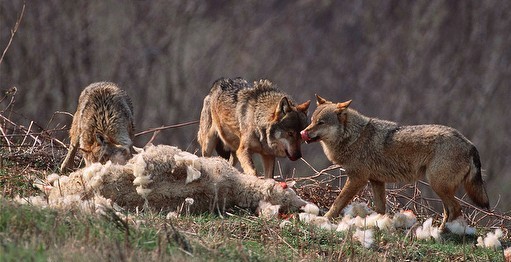A federal judge in northern California ruled gray wolf populations in the Great Lakes region must be reinstated on the threatened and endangered species list (TESL).
The February 10 ruling by U.S. District Judge Jeffrey White, overturns a U.S. Fish and Wildlife Service (FWS) decision to delist the Great Lakes area wolf populations, in October 2020. The FWS had determined gray wolves in the upper mid-west had exceeded the recovery goals set by the agency with pack sizes large and numerous enough to be counted as successfully recovered.
After state agencies in the region developed wolf management plans that were approved by the FWS, responsibility for managing wolf populations was returned to the states in the region, including Michigan, Minnesota, and Wisconsin.
With large populations of wolves, some states reinstituted limited hunting seasons for them to control their population, and limit any threat they posed to humans or livestock. Wisconsin, for example, implemented a short wolf hunt in February of 2021 during which 218 wolves were harvested across three days.
The Federal court’s ruling negates states’ authority to manage wolves, placing the responsibility back with the federal government.
Not All Wolves Covered
Although the environmental groups that had challenged the federal government’s decision to remove wolves from the TESL, hope the court would require all wolves across the nation to be relisted as endangered or threatened, the court did not mandate the federal government relist wolf populations in the Northern Rockies.
White pointed out, packs in Northern Rocky states had specifically been delisted by a law passed by Congress after courts had repeatedly intervened and blocked multiple attempts by the FWS to delist the Northern Rocky wolves as recovered and healthy. What Congress imposed through law, White said he was precluded from overturning.
In order for gray wolves in the Northern Rockies to be listed as threatened or endangered, petitioners will have to go through the regulatory processes prescribed and law and regulation for such listings.
Activism Trumped Science
This ruling was a great example of forum shopping, and comes at the expense of professional wildlife management, the goal of the act to recover wolves, and to the detriment of the people in the Great Lakes region, said Kaitlynn Glover, executive director of Natural Resources for the National Cattlemen’s Beef Association and Public Lands Council, executive director, in a statement.
“Today’s decision conflicts with the intended purpose of the Act and removes critical management tools for wolves that pose a tremendous threat to farmers and ranchers, rural economies, and vital land and natural resource conservation,” said Glover. “It’s disappointing that environmental activism carried more weight than science in this case.
“Rather than ruling on due process and adherence to recovery criterion, Judge White chose to remand the rule and undermine one of the most successful ESA recovery stories in United States history,” said Glover. “ESA should not be used as a permanent management tool.”
Loss of State Control
Contrary to White’s assessment, gray wolf populations across Michigan’s Upper Peninsula (UP), northern Wisconsin, and northern Minnesota have recovered to very healthy population levels, Michigan state Rep. Greg Markkanen (R-Hancock), told Environment & Climate News.
“What this decision means is we lose control as a state,” Markkanen said. “It is very disturbing because a judge in California has no idea what is going on in our state and across the Upper Peninsula and Northern Michigan, Wisconsin and Minnesota.”
“The original goal was 200 wolves—some estimates now have the wolf population in the UP at over 1,000,” Markkanen said. “The white-tailed deer season and the fall hunting season in the UP area is almost a billion-dollar industry, and we had areas that were once quite productive. and now people aren’t even hunting there anymore because there aren’t any deer; people are very disturbed by the fact that someone in California can make a judgement call about what is going on in Michigan.”
Businesses are Suffering
For most of Michigan’s history, the Upper Peninsula (UP) was known for its white-tailed deer population, and a sizable number of deer hunters from downstate Michigan came up even before there was a Mackinac Bridge, says Markkanen.
“People would wait for days to get across on the ferry for an opportunity to hunt in the UP,” Markkanen said. “Now many businesses are losing money in the fall, because there are no archery, firearm and black powder hunts and there are areas in the UP where dogs are disappearing, and a farmer in the Eastern UP lost 30 plus sheep to wolves.
“It is becoming devastating to our economy in the fall,” Markkanen said. “Hunters, trappers, and farmers in the UP are not looking to wipe out the wolf population like they did in the lower peninsula 150 years ago, they just want the state to be able to manage them, and they want outdoorsmen, who really finance the Department of Natural Resources in the state, to be in on the management plan.”
Kenneth Artz (KApublishing@gmx.com) writes from Dallas, Texas.


























